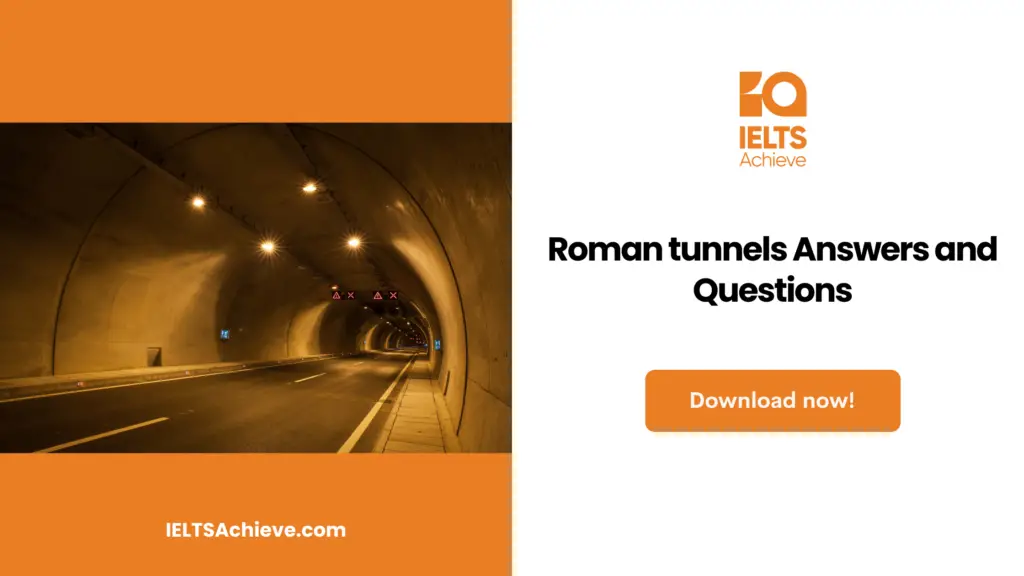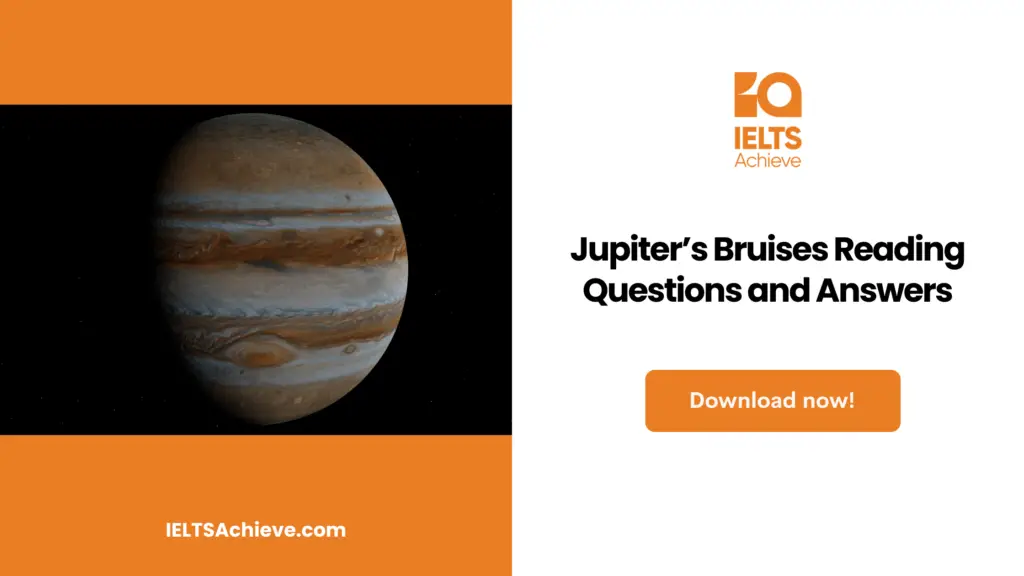The Blog post contains the following IELTS Reading Questions:
- IELTS reading multiple choice questions
- IELTS reading true false not given questions
- IELTS reading summary completion
Stay informed and prepared for success – Explore our comprehensive Reading Test Info page to get valuable insights, exam format details, and expert tips for mastering the IELTS Reading section.
IELTS reading passage – Roman tunnels

Roman tunnels
The tunnels were constructed by the Persians, to provide a reliable water supply to the human settlements in the dry areas of present-day Iran. Quant method of tunnel construction was introduced in the early first millennium BCE where the posts are placed in a straight line over a hill and vertical shafts are dug at regular intervals into the grounds, thus ensuring the route of the tunnel. The earth between the ends of the shaft are removed by the workers in the underground to create a tunnel. The shafts are used to remove the excavated soil to the ground and also provide ventilation during the work.
The knowledge about the quant method of constructing tunnels for water supply for agriculture was transferred by the Persians to the Romans. Vertical shafts dug with a 30 and 60 metre interval were used in the Roman quant tunnels. To aid in moving in and out of the shafts, they are equipped with footholds and handholds and wooden or stone lids are used to close the shafts. Romans hung a plumb line at the top of the shaft with a help of the rod placed across it to check whether the shaft is vertical and assured the weight is hanging in the middle of the shaft. It is also used to identify the tunnel slope and to determine the shaft depth. The Claudius tunnel was built in 41 CE for draining the Fucine Lake in Central Italy is 5-6 Kilometres long with a 122 metres deep shaft. It took approximately 30,000 employees to complete the tunnel in 11 years. Remarkably, the ancient roads are still used today for transportation. Mineral extraction tunnels were also built. Counter-excavation tunnel construction was the second tunnel building methodology, originated in the 6th century BCE, where tunnels were built from both the ends. This method is adopted to cut through the mountains where quants implementation is not a practical alternative. As both ends of the tunnel have to meet at the center of the mountain, a great plan and advanced planning is required for implementing this method. Whenever there is a chance of geological problems or the paths have been deviated, direction adjustments have to be made. The advancing direction of the tunnel is constantly checked, for example light penetration from the mouth of the tunnel will be looked back and if any deviations are found corrections will be made. At times there is a possibility of having large deviations causing one end to be unused. The Saldae aqueduct system located in modern-day Algeria, is built by the Romans, is 428-meters long and the workers failed to meet the ends in the mountain. An inscription written on the tunnel explains how they missed and how it was later altered using a lateral link between the corridors to rectify the error.
The Romans used the counter-excavation method to construct tunnels for roads, in places where they encountered mountains and hills that are too high to cross. The 37-meter long and 6-meter high Furlo Pass tunnel in Italy built in 69-79 CE is an example of counter excavation roads. Once mineral veins are located, the miners pursue building a tunnel using the shafts in the underground. An example of this type of tunnel can be found at the Dolaucothi mines in Wales, which is used for mining gold. The construction planning is simple and the routes will be determined only based on the mineral vein if the sole purpose of the tunnel is mineral extraction.
All the Roman tunnel constructions are carefully planned and executed well. The tunnel construction method and the type of rock in the excavation area will determine the length of the time required for building the tunnel. As the quant construction method uses a straight forward approach, the work is faster than a counter-excavation method. This is because apart from excavating only from the tunnel mouth, even the shats can be used for excavation. The construction time is also affected by the type of rock.
The Romans employed a technique named fire quenching, where they would heat the rock and suddenly cool it with cool water to create a crack in the hard rocks. As the tunnel progression across the hard rocks requires a lot of time, the tunnel construction takes years to complete and sometimes a decade to build a tunnel. The rate of advance through the solid rock was only 30 centimetres per day and it is indicated using the construction marks in the Roman tunnel of Bologna. In contrast, the rate of advancement in the Claudius tunnel is 1,4-metres per day. The names of the patrons who started the tunnel project and the architect names are inscripted in most of the tunnels. For example, still today you can find the inscription in the 1.4-kilometer Cevlik tunnel in Turkey. Here the tunnel starting 69 CE and the completed year 81 CE will be found. The tunnel is built to divert the floodwater from flowing into the harbours of the ancient city of Seleuceia Pieria.
Unlock your full potential in the IELTS Reading section – Visit our IELTS Reading Practice Question Answer page now!
Recommended Questions:
Renewable Energy IELTS Reading Question with Answer
Roman tunnels IELTS reading questions
Question (1-5)
Choose the correct letter, A – D
1. Some of the quants built by the Persians _____________ ago are still in use today.
- 2800 years
- 3000 years
- 2700 years
- 2400 years
2. Counter-excavation tunnel construction was the ____________ tunnel construction methodology used by the Romans.
- Fifth
- Second
- First
- Third
3. Prior planning and construction strategy is required as the tunnel has to meet in the __________ of the mountain
- Top
- Bottom
- Centre
- None of the above
4. The Saldae aqueduct system is _____________ long
- 444 metres
- 428 metres
- 424 metres
- 448 metres
5. _______________ affects the construction time
- Nature of soil
- Nature of rocks
- Nature of mineral
- None of the above
Ready to improve your performance in Multiple Choice Questions (MCQs)? Click here to access our comprehensive guide on how to tackle MCQs effectively in the IELTS Reading section.
Question (6-9)
Do the following statements agree with the information given in the reading passage?
Write
- TRUE if the statement agrees with the information
- FALSE if the statement contradicts the information
- NOT GIVEN if there is no information on this in the passage
6. The knowledge about the tunnel construction was transferred from Persians to Romans.
7. The roads constructed by counter-excavation methods are not used in today’s modern transportation.
8. Romans tunnel construction knowledge was spread world wide.
9. Heating and sudden cooling of rocks are done creating a crack in the rock.
Enhance your skills in identifying information as True, False, or Not Given. Click here to discover expert strategies and techniques for mastering this question type in the IELTS Reading section.
Question (10-13)
Complete the summary below.
Write NO MORE THAN THREE WORDS from the passage for each answer
Tunnels were originally constructed by 10. ____________ to supply water to the human settlements. Later the knowledge about the
11 ________________________ of tunnel was transferred to the Romans. After using the Shaft tunnel construction method, the Romans started using the
12. ____________ construction method.
This method was used to build 13________ where crossing the mountains is difficult.
Boost your performance in Summary, Notes, Table, and Flowchart Completion tasks. Click here to explore our detailed guide and learn how to effectively complete summaries, notes, tables, and flowcharts in the IELTS Reading section.
Unlock your full potential in the IELTS Reading section – Visit our IELTS Reading Practice Question Answer page now!
Recommended Questions:
Renewable Energy IELTS Reading Question with Answer
Roman Tunnels IELTS reading answers
1. C. 2700 years
2. Answer: B. second
3. Answer: C. center
4. Answer: B 428 meters
5. Answer: B Nature of rocks
6. Answer: True
7. Answer: False
8. Answer: Not given
9. Answer: True
10. Answer: Persians
11. Answer: Quant method
12. Answer: Counter excavation tunnel
13. Answer: Road

We hope you found this post useful in helping you to study for the IELTS Test. If you have any questions please let us know in the comments below or on the Facebook page.
The best way to keep up to date with posts like this is to like us on Facebook, then follow us on Instagram and Pinterest. If you need help preparing for the IELTS Test, join the IELTS Achieve Academy and see how we can assist you to achieve your desired band score. We offer an essay correction service, mock exams and online courses.

